
Ithomiini is a butterfly tribe in the nymphalid subfamily Danainae. It is sometimes referred to as the tribe of clearwing butterflies or glasswing butterflies. Some authors consider the group to be a subfamily (Ithomiinae). These butterflies are exclusively Neotropical, found in humid forests from sea level to 3000 m, from Mexico to Argentina. There are around 370 species in some 40–45 genera.
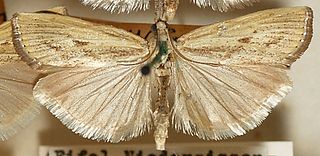
Agriphila inquinatella is a small moth species of the family Crambidae. It is found in Europe, around the Caucasus area to Turkestan, and in the Near East to Jordan. The type locality is in Austria.

Chilo phragmitella is a species of moth of the family Crambidae, sometimes referred to by the vernacular names wainscot veneer or reed veneer. It was first described by Jacob Hübner between 1805 and 1810 as Tinea phragmitella, and is the type species of the genus Chilo.

Polygrammate is a monotypic moth genus of the family Noctuidae. Its only species, Polygrammate hebraeicum, the Hebrew moth or Hebrew, is found in the eastern parts of North America, from Ontario, south to Florida and as far west as Texas. Both the genus and the species were first described by Jacob Hübner in 1818.

Eois is a genus of tropical moths in the family Geometridae. It was first described by Jacob Hübner in 1818. Caterpillars of Eois species are most commonly green with darker markings, but species with fully dark caterpillars also exist. They are specialized feeders associated with Piperaceae species, with sparse additional records on Chloranthaceae species. Adults are typically small, with diverse wing shape, color and patterning across the genus.
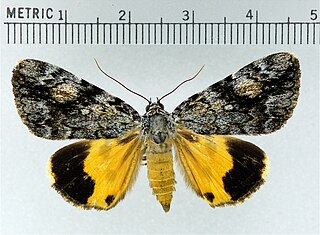
Catocala amica, the girlfriend underwing, is a moth of the family Erebidae. The species was first described by Jacob Hübner in 1818. It is found from southern Canada through the United States east of the Rocky Mountains, ranging westward to Oklahoma and Arizona, northward to Minnesota and southwestward to Texas.

Tinea trinotella is a species of tineoid moth. It belongs to the fungus moth family (Tineidae), and therein to the nominate subfamily Tineinae. It was once used as type species of a distinct genus Acedes, but this is synonymized today with Tinea, the type genus of Tineinae, Tineidae and the superfamily Tineoidea.

Isotrias is a genus of moths belonging to the family Tortricidae.

Euxoa eruta is a moth of the family Noctuidae. It is found in Italy, Spain, France, Germany, Denmark, Fennoscandia, Austria, Switzerland, Hungary, Bulgaria, the Czech Republic, Greece, Turkey, Belarus, the Baltic region, Siberia and from central Asia up to the Altai Mountains. Note that E. eruta may not be a good species. The Euxoa tritici complex consists of five sibling species in Europe: Euxoa tritici, Euxoa nigrofusca, Euxoa eruta, Euxoa diaphora Boursin, 1928 and Euxoa segnilis. Furthermore, although Fibiger (1997) treated Euxoa montivaga differently it belongs to the E. tritici complex. Differences among the species are subtle, the most important diagnostic characteristics being genitalic. In studies of three of these species, E. tritici, E. nigrofusca and E. eruta, no support was found for the presence of several morphologically distinguishable species with quantitative morphometric analyses.
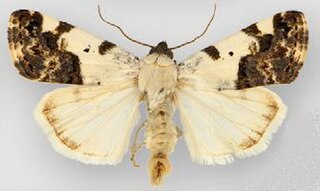
Tarache aprica, the exposed bird dropping moth, is a moth of the family Noctuidae. The species was first described by Jacob Hübner in 1808. It is found in North America from Ontario and Quebec to Florida, west to Arizona, north to Kansas and Iowa. There are some records from Great Britain, but this probably relates to imports.
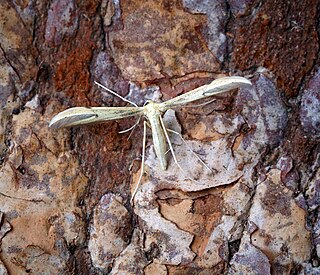
Hellinsia carphodactyla is a moth of the family Pterophoridae, first described by Jacob Hübner in 1813. It is known from most of Europe, Asia Minor and North Africa.

Elachista albifrontella is a moth of the family Elachistidae found in Europe.

Isotrias stramentana is a species of moth in the family Tortricidae. It is found in Spain, France, Italy, Switzerland and Germany.
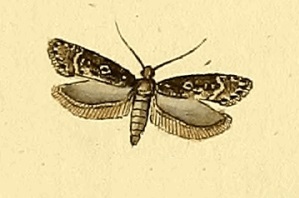
Gelechia sororculella, the dark-striped groundling, is a moth of the family Gelechiidae. It is widely distributed from Europe, throughout Siberia to the Russian Far East.

Isotrias rectifasciana, the hedge shade, is a species of moth of the family Tortricidae found in Asia and Europe. The moth was first described by the English entomologist, Adrian Hardy Haworth in 1811.
Isotrias penedana is a species of moth of the family Tortricidae. It is found in the Serra da Peneda in north-western Portugal.

Scythris inspersella, the Norfolk owlet, is a moth of the family Scythrididae, first described by the German entomologist Jacob Hübner in 1817. It has a Holarctic distribution.















